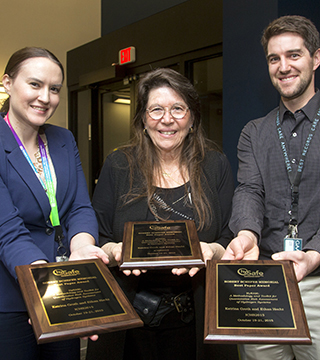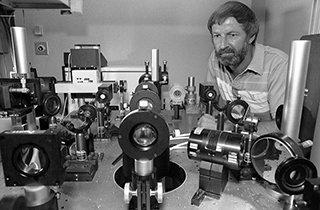Katrina Groth and Ethan Hecht win inaugural Robert Schefer Best Paper award

“It just blows me out of my shoes to meet these two amazing young people who are following in my husband’s footsteps,” says Jade Schefer, wife of the late Robert Schefer, of Katrina Groth, left, and Ethan Hecht, inaugural recipients of the ICHS Robert Schefer Best Paper award. (Photo by Randy Wong)
In October, Sandia scientists Katrina Groth and Ethan Hecht were recognized at the IA-HySafe International Conference on Hydrogen Safety with the inaugural Robert Schefer Best Paper award.
The award honors the late Robert (Bob) Schefer, formerly a researcher at Sandia’s Combustion Research Facility, for his contributions to characterization and understanding of the hydrogen behavior when unintentionally released at conditions relevant to hydrogen fueling infrastructure. Bob’s work has been key to the validation of numerical simulations of hydrogen behavior and the development of analytical models that capture the basic physics of these behaviors for use in codes and standards.
Katrina and Ethan’s paper, “HyRAM: A Methodology and Toolkit for Quantitative Risk Assessment of Hydrogen System” was chosen from 167 submissions to the conference. The selection panel included seven technical experts from the ICHS scientific committee representing the countries of China, Germany, Ireland, Japan, the Netherlands, the United Kingdom, and the United States.
Katrina and Ethan were honored at a ceremony held at Sandia on Nov. 19. In attendance were Bob’s widow, Jade; Sunita Satyapal, director of the DOE Fuel Cell Technologies office (FCTO); Erika Sutherland, technology development manager, FCTO; Will James, Safety, Codes, and Standards project manager, FCTO; Bob’s Sandia colleagues; and representatives from the broader hydrogen safety community. FCTO’s Safety, Codes and Standards project funds the risk and the hydrogen behavior work at Sandia, including Bob’s research, and now that of Katrina and Ethan.
“Bob’s turbulent combustion research was critical to successful computer modeling of hydrogen releases from day one. The entire hydrogen codes and standards community continues to reference his work, as does the scientific community in hydrogen combustion,” says Art Pontau, senior manager of Combustion and Industrial Technology at Sandia.
Data still used extensively
Bob, a mechanical engineer, joined Sandia in 1981 and worked in thermofluidics, combustion physics, and reacting flow as well as hydrogen and combustion technology until his death in 2010. His research on turbulent combustion provided data that continues to be used extensively to validate models of hydrogen releases, which are needed to support the deployment of hydrogen refueling infrastructure and code development for hydrogen safety.

Katrina and Ethan’s paper describes the Hydrogen Risk Assessment Model (HyRAM), a methodology and accompanying software toolkit that integrates the risk-assessment process with the detailed physics of hydrogen behavior. HyRAM enables scientifically based codes and standards for hydrogen technologies and infrastructure that are consistent, logical and defensible. The toolkit also facilitates risk-informed engineering design and decision-making processes.
“To calculate risk, HyRAM uses the physical models validated by Bob Schefer’s data,” says Jay Keller, a former hydrogen program manager at Sandia, now president of Zero Carbon Energy Solutions. “It’s very fitting that the inaugural Bob Schefer award recognizes work that was made possible by his significant contributions to the international community for hydrogen codes and standards.”